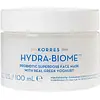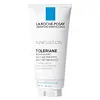KORRES Greek Yoghurt Probiotic SuperDose Face Mask Versus La Roche-Posay Toleriane Caring Wash Cleanser
What's inside
What's inside
 Key Ingredients
Key Ingredients

 Benefits
Benefits

 Concerns
Concerns

 Ingredients Side-by-side
Ingredients Side-by-side

Water
Skin ConditioningYogurt
Skin ProtectingGlycerin
HumectantHexyldecyl Stearate
EmollientDiisostearyl Malate
EmollientPrunus Armeniaca Kernel Oil
MaskingSqualane
EmollientC14-22 Alcohols
Emulsion StabilisingIsoamyl Laurate
EmollientPrunus Amygdalus Dulcis Oil
Skin ConditioningArachidyl Alcohol
EmollientPentylene Glycol
Skin ConditioningButyrospermum Parkii Butter
Skin ConditioningPEG-100 Stearate
Aloe Barbadensis Leaf Juice Powder
Skin ConditioningAlgin
MaskingAlpha-Glucan Oligosaccharide
CleansingArachidyl Glucoside
EmulsifyingAscorbyl Palmitate
AntioxidantBehenyl Alcohol
EmollientBisabolol
MaskingC12-20 Alkyl Glucoside
EmulsifyingCaprylyl Glycol
EmollientChlorella Vulgaris Extract
Skin ConditioningDisodium Phosphate
BufferingEpigallocatechin Gallatyl Glucoside
AntioxidantEthylhexylglycerin
Skin ConditioningGallyl Glucoside
AntioxidantGlyceryl Polyacrylate
Helianthus Annuus Seed Oil
EmollientHydrogenated Palm Glycerides
EmollientHydrogenated Palm Kernel Glycerides
EmollientHydrolyzed Sodium Hyaluronate
Skin ConditioningHydroxyethyl Acrylate/Sodium Acryloyldimethyl Taurate Copolymer
Emulsion StabilisingLactic Acid
BufferingLactobacillus
Skin ConditioningLaminaria Digitata Extract
Skin ProtectingLecithin
EmollientLonicera Caprifolium Flower Extract
PerfumingLonicera Japonica Flower Extract
Skin ConditioningMaltodextrin
AbsorbentMaris Aqua
HumectantOzonized Oryza Sativa Callus Culture Extract
Skin ConditioningPhenethyl Alcohol
MaskingPolymnia Sonchifolia Root Juice
Skin ConditioningPotassium Phosphate
BufferingPropyl Gallate
AntioxidantPullulan
Saccharide Isomerate
HumectantSerine
MaskingSodium Carboxymethyl Beta-Glucan
CleansingSodium Hyaluronate
HumectantSodium Polyacrylate Starch
AbsorbentTetrasodium Glutamate Diacetate
Tocopherol
AntioxidantTrehalose
HumectantUrea
BufferingZingiber Officinale Root Extract
MaskingBenzyl Alcohol
PerfumingPhenoxyethanol
PreservativeSalicylic Acid
MaskingSorbic Acid
PreservativeParfum
MaskingWater, Yogurt, Glycerin, Hexyldecyl Stearate, Diisostearyl Malate, Prunus Armeniaca Kernel Oil, Squalane, C14-22 Alcohols, Isoamyl Laurate, Prunus Amygdalus Dulcis Oil, Arachidyl Alcohol, Pentylene Glycol, Butyrospermum Parkii Butter, PEG-100 Stearate, Aloe Barbadensis Leaf Juice Powder, Algin, Alpha-Glucan Oligosaccharide, Arachidyl Glucoside, Ascorbyl Palmitate, Behenyl Alcohol, Bisabolol, C12-20 Alkyl Glucoside, Caprylyl Glycol, Chlorella Vulgaris Extract, Disodium Phosphate, Epigallocatechin Gallatyl Glucoside, Ethylhexylglycerin, Gallyl Glucoside, Glyceryl Polyacrylate, Helianthus Annuus Seed Oil, Hydrogenated Palm Glycerides, Hydrogenated Palm Kernel Glycerides, Hydrolyzed Sodium Hyaluronate, Hydroxyethyl Acrylate/Sodium Acryloyldimethyl Taurate Copolymer, Lactic Acid, Lactobacillus, Laminaria Digitata Extract, Lecithin, Lonicera Caprifolium Flower Extract, Lonicera Japonica Flower Extract, Maltodextrin, Maris Aqua, Ozonized Oryza Sativa Callus Culture Extract, Phenethyl Alcohol, Polymnia Sonchifolia Root Juice, Potassium Phosphate, Propyl Gallate, Pullulan, Saccharide Isomerate, Serine, Sodium Carboxymethyl Beta-Glucan, Sodium Hyaluronate, Sodium Polyacrylate Starch, Tetrasodium Glutamate Diacetate, Tocopherol, Trehalose, Urea, Zingiber Officinale Root Extract, Benzyl Alcohol, Phenoxyethanol, Salicylic Acid, Sorbic Acid, Parfum
 Reviews
Reviews

Alternatives
Ingredients Explained
These ingredients are found in both products.
Ingredients higher up in an ingredient list are typically present in a larger amount.
Caprylyl Glycol is a humectant and emollient, meaning it attracts and preserves moisture.
It is a common ingredient in many products, especially those designed to hydrate skin. The primary benefits are retaining moisture, skin softening, and promoting a healthy skin barrier.
Though Caprylyl Glycol is an alcohol derived from fatty acids, it is not the kind that can dry out skin.
This ingredient is also used as a preservative to extend the life of products. It has slight antimicrobial properties.
Learn more about Caprylyl GlycolGlycerin is already naturally found in your skin. It helps moisturize and protect your skin.
A study from 2016 found glycerin to be more effective as a humectant than AHAs and hyaluronic acid.
As a humectant, it helps the skin stay hydrated by pulling moisture to your skin. The low molecular weight of glycerin allows it to pull moisture into the deeper layers of your skin.
Hydrated skin improves your skin barrier; Your skin barrier helps protect against irritants and bacteria.
Glycerin has also been found to have antimicrobial and antiviral properties. Due to these properties, glycerin is often used in wound and burn treatments.
In cosmetics, glycerin is usually derived from plants such as soybean or palm. However, it can also be sourced from animals, such as tallow or animal fat.
This ingredient is organic, colorless, odorless, and non-toxic.
Glycerin is the name for this ingredient in American English. British English uses Glycerol/Glycerine.
Learn more about GlycerinTocopherol (also known as Vitamin E) is a common antioxidant used to help protect the skin from free-radicals and strengthen the skin barrier. It's also fat soluble - this means our skin is great at absorbing it.
Vitamin E also helps keep your natural skin lipids healthy. Your lipid skin barrier naturally consists of lipids, ceramides, and fatty acids. Vitamin E offers extra protection for your skin’s lipid barrier, keeping your skin healthy and nourished.
Another benefit is a bit of UV protection. Vitamin E helps reduce the damage caused by UVB rays. (It should not replace your sunscreen). Combining it with Vitamin C can decrease sunburned cells and hyperpigmentation after UV exposure.
You might have noticed Vitamin E + C often paired together. This is because it is great at stabilizing Vitamin C. Using the two together helps increase the effectiveness of both ingredients.
There are often claims that Vitamin E can reduce/prevent scarring, but these claims haven't been confirmed by scientific research.
Learn more about TocopherolWater. It's the most common cosmetic ingredient of all. You'll usually see it at the top of ingredient lists, meaning that it makes up the largest part of the product.
So why is it so popular? Water most often acts as a solvent - this means that it helps dissolve other ingredients into the formulation.
You'll also recognize water as that liquid we all need to stay alive. If you see this, drink a glass of water. Stay hydrated!
Learn more about Water